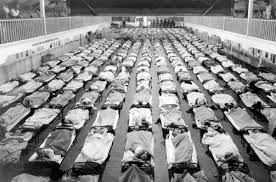Epidemic/Pandemic
And epidemic is what you get when the number of people infected by a disease rises well beyond what is expected and impacts all levels of a community. When that epidemic covers a much larger geographical area, or becomes worldwide, it is called a pandemic.
Pandemics were essentially impossible for most of human history, since rarely would an infected person be able to travel. However, now, people traavel outside of their immediate community fast enough to spread a disease. It was hard to find a great and certain answer to this, but the most convincing answers were that 1.73 million passengers on domestic flights in the US every day in 2010, and some estimate 4.5 million per day around the world. One site claims that 3 million leave the US each day, but did not mention how many come in… In 2012, TSA claimed 1.88 million people a day in the US go through security checks.
This means that any disease (particularly a virus) that gains a foothold in a foreign country can be transported here, or anywhere else before the infected person might even show symptoms.

If the nation where the infection begins is a fairly closed news outlet, like China, or many of the Muslim Theocracies, the infection could be ingrained and spreading before anyone knew to respond. This has happened in the recent past… like with the Avian flu and H1N1.
Influenza is a particularly dangerous virus because it is almost always good at spreading from person to person.
Fortunately, especially in 1st world nations, though the flu spread to vast numbers of people, none of the recent strains have been very lethal where treatment was possible.
There have been about 3 influenza pandemics in each century for the last 300 years. In about the last 100 years, one of the scary ones to look back on was the flu of the late 1890s and into the early 1900’s… called “The Spanish Flu”. In those years, an estimated 30-50 million apparently died… 675,000 of which were Americans! (about the same as died in the entire Civil War).

Those are some scary numbers, for sure and fortunately, we have not had another outbreak like that since then, at least not here. However, outbreaks have not been rare and deaths in the millions worldwide. Recent outbreaks that have hit since the Spanish flu include:
1956 1-4 million deaths worldwide
1968 1 million deaths worldwide (33k in the US)
2009 (H1N1) 280k deaths worldwide.
The CDC estimates (http://www.cdc.gov/h1n1flu/estimates_2009_h1n1.htm) that in the year of April 2009 – April 2010, there were between 43 million and 89 million cases of H1N1 in the US… 195k-403k hospitalizations, and between 8,870-18,300 deaths! H1N1 was apparently fairly good at transferring from person to person, but not particularly lethal.
Though there are effective anti-viral treatments, they are easily overwhelmed in cases like this. In the case of another major outbreak… or even just an impressive one… likely much commerce and retail would either sell out or shut down. What happens when people are encouraged by the CDC to “stock up” for a few weeks in the case an a pandemic?
I know that here in Tyler, when we know we are having a cold snap (anything below 32 degrees F), the grocery stores sell out of things! I would assume that most stores would be packed with people (some of whom could be carrying the virus, incidentally) and sold out in hours.
Most stores today run with scientific efficiency. They “store” little at the “stores” beyond what they can expect to sell in the immediate future. Even one or two days of delayed shipments and they could be almost empty, even with normal shopping numbers… imagine the effect of that in a crisis when people need to hunker down and stay home for a week or two – so they try to stock up! Combine those and get a mess. Especially if the truckers are trying to stay home to avoid getting sick. Have a scary enough outbreak and I assume they would.
Conclusion? Here is another motivation to have some supplies on hand. Enough to provide for you family (and maybe some neighbors) for a few weeks. Most likely, by then, the pandemic will have largely passed (even if it leaves a path of death behind it) and your family will have helped reduce rather than help encourage the panic and consequences of the epidemic.
Once again, though the chances of this kind of pandemic in the US is debated, and very unlikely any given year, it has happened before and our society is in many ways less vulnerable to the flu, but more vulnerable to the shut downs it could create… less vulnerable to the disease itself, but more able to spread it quickly.
Pingback: Still Not Convinced to Prepare? – Chris Legg
Pingback: Planning or Prepping? | Chris Legg, LPC
Pingback: Prepping or Preparing for the grid down | Chris Legg, LPC
Grocery stores operate on a very thin margin. Like most businesses, the majority of money spent to operate is on payroll. But a very close second is spent on inventory. People like me are hired to reduce that cost as much as possible, meaning on hand product is kept to a minimum in order to reduce operating expenses.
That said, most medium to large size grocery chains maintain contingency planning and emergency readiness to respond to incidents such as weather related disasters, power outages (which happen more frequently than you may imagine but on a small scale), and outbreaks. As a matter of fact, my company maintains a large supply of bottle water for hurricane season.
Plans like these help in emergency situations to maintain supply routes to grocery stores. But the plans are reactionary and require a great deal of coordination which takes time. Preparedness among our customers helps reduce the impact to supply routes and increases the effectiveness of these plans.
wow – straight from the mouth of the man who is in the know – thanks for the insight David!
May I add a plug for the flu vaccine? It is available now to protect against this season’s flu. Early influenza cases have been reported, but the bulk of the season has not yet hit and there still is time to get the flu shot.
More flu statistics from the CDC:
“During the past three decades, the estimated number of annual influenza-associated deaths from respiratory and circulatory causes ranged from a low of 3,349 to a high of 48,614 deaths…
“A previous study presented an average annual estimate of 25,420 influenza-associated respiratory and circulatory deaths during a 23-season period; this study estimated an average of 23,607 annual influenza-associated deaths using the same model but over a 31-year period.”
http://www.cdc.gov/mmwr/preview/mmwrhtml/mm5933a1
There is a product out there call Miracle Mineral Supplement, which I have used repeatedly for illness and injury. It works wonders. Find it online. GET IT! Trust me on this. We are soon going to need it.